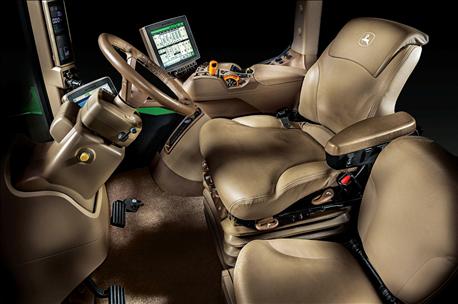March 8, 2016

It's pretty easy when you're writing about equipment to get goo-goo eyes over the very latest technology from monitors to ISOBUS and the cloud. Yet at the end of the day a planter has to plant, a sprayer has to spray and a combine has to combine. Over the last five years we've seen – in the midst of high crop prices – a significant rise in the innovation of equipment.
Today a planter has to plant but it may be with electric meters that can be individually controlled with increased precision. The sprayer has to spray but with pulse-width modulation getting more popular – by the way that tech has been around more than 20 years – the precision level of your spraying is amazing.

Today's modern cabs offer comfort, but also monitors that can control a lot of equipment. But at the end of the day a planter has to plant, a sprayer has to spray. And what is your monitor approach? (Photo: John Deere)
As for the combine, the shift to predominance in the use of rotary systems offers customers flexibility in crops. Conventional combines are still out there, but rotary systems carry the bulk of the market share.
Tying all this together is the over-arching ISOBUS a global communication standard that allows tractor and implement to talk to each other. I hadn't thought much about ISOBUS lately, since I've covered it in the past, knowing that it can enhance your efficiency when appropriately applied. But something interesting happened at Commodity Classic last week.
I was visiting the Agco booth and talked someone there about the new Sunflower air seeder, when I asked the price I was quoted the price with monitor and the price without. I asked why would someone buy an air seeder without a monitor.
That's when he pointed to the ISOBUS port on the planter and noted that the machine was ISOBUS compliant and that if you had a compliant monitor in the tractor cab you wouldn't need a second monitor just for the planter. That's kind of been my focus for a few years – a single monitor in the cab that allows you to control everything. That may be coming, but then another question arises.
Monitor management
On the monitor issue I had a conversation with someone recently about a machine that had to have its own monitor added to the cab. I made my standard statement about wanting it all on one monitor (yes I'm a one-note wonder on this topic) and this source opened my eyes to two different schools of thought.
The first is the single monitor approach where you may have to "page" from one area to another to see what's happening. That is one approach and does reduce monitor clutter in the cab. However, it doesn't always mean key information is "up front" where you need it. Though this is the approach I like, you may be a quick-glance operator who needs to see everything at once.
The second approach is the multi-monitor approach, creating a kind of cockpit of readouts where you can glance right where you need to when checking operation of the tractor or the trailed implement. It's an approach I hadn't thought of, and one that might be more efficient for many operators.
So I'll back away a bit from my "one monitor to rule them all" notion. And start looking at the monitors themselves to see if the readouts and the information you're getting is crisp, clean and a nice user experience. Then you can decide the best approach.
However, with ISOBUS compliant systems at least you're more likely to have a choice than you would in the past. Essentially I'll be looking at that dashboard to see how information is presented and ways it could be done better.
And as for my starting thesis about equipment and tech – industry standards like ISOBUS will make a difference in the future for engineers and designers to help make sure that when you want to plant, spray or combine, your first step isn't waiting for the computer to reboot. I hear too many of those stories today and it's a hiccup in the advancement of this technology that companies have to solve.
About the Author(s)
You May Also Like






